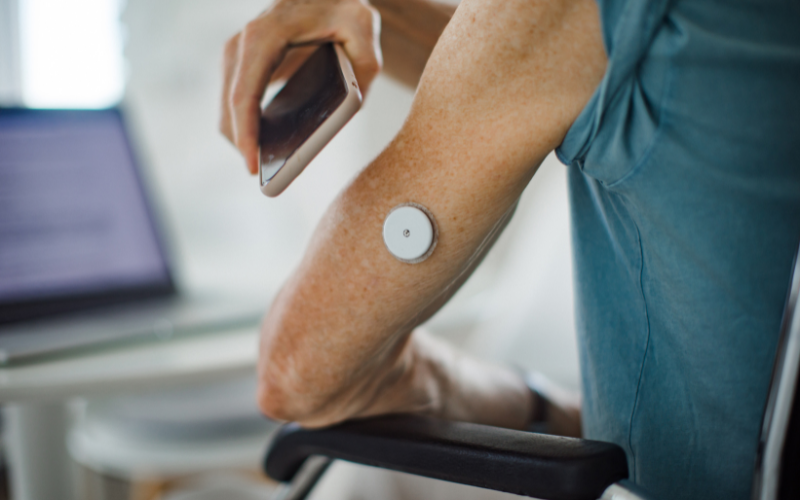Blockchain Technology in Diabetes Management: Opportunities and Challenges

Blockchain technology has the power to revolutionize healthcare. It allows us to get a fresh approach to health information exchanges (HIE). This tech makes electronic medical records more efficient, by removing intermediaries, and fortifying security.
Although it is not a cure-all, it is a rapidly advancing field. It has a huge potential for investment, experimentation, and proof-of-concept testing.
The global market for blockchain in healthcare was valued at $0.76 billion in 2022, but experts predict that by 2032, this transformative technology will soar to an estimated $14.25 billion. This represents an impressive compound annual growth rate (CAGR) of 34.02% for the forecast period of 2023 to 2032. The potential of blockchain in revolutionizing healthcare is truly remarkable.
With blockchain, we could have a decentralized and secure platform where our health data is stored. This ensures privacy and reduces the risk of data breaches.
Think about the convenience of having all your medical records, test results, and treatment plans accessible from anywhere, anytime.
But, blockchain is not without its flaws. Here, I want to talk about the potential that blockchain technology holds in transforming the way we handle diabetes care. I also want to highlight the challenges that come with it. So, let’s dive right in.
What Is Blockchain Technology?
Blockchain technology is an advanced database mechanism. It is a sophisticated system for storing and managing data. It acts as a public, distributed, and decentralized digital ledger.
Jacob Kostecki, an expert from Blockhead Factor, explains that the nature of blockchain makes it ideal for capturing medical histories, research, and treatment details.
Currently, medical information is fragmented and often unreliable. This leads to a lack of trust and causes delays in patient diagnosis and treatment.
In a blockchain-powered ecosystem, patients will have their comprehensive medical histories stored in a digital wallet. That means records, procedures, and all relevant information from birth to the present.
Which Blockchain Is Used in Healthcare?
Blockchain can be used for different elements in healthcare. That includes managing medical records, recording clinical trials, tracing prescription medicine, supply chain management, telemedicine, and safely managing medical device data.
This technology is highly versatile. With blockchain, drug development can be more efficient and transparent. Since experts can use it to store and share data, this technology can aid in personalized medicine.
Based on a study published in the International Journal of Intelligent Networks, blockchain technology brings findings and credibility to clinical trials. Blockchain technology creates a unique code, known as a hash, for each block containing patient health records.
The blockchain system can encourage us (patients) to show our data to third parties. At the same time, we get to maintain our anonymity.
Opportunities of Blockchain Technology in Diabetes Care
Blockchain technology has a lot to offer for diabetes care. It can compile and manage reports, improve the seamless sharing of diabetes-related information, support remote monitoring, and facilitate the sharing of diabetes research data.
Here is a quick look at the benefits of blockchain technology in diabetes management.
Compilation of Patient Records
The healthcare sector faces several problems when it comes to data sharing, storage, and verification. Patient data is fragmented into isolated compartments. This makes it difficult for doctors to access the data when necessary.
Meanwhile, hackers can easily do it. This lack of control leaves me feeling like I don’t own my health information. I’ve seen many cases of data breaches and unauthorized access. And to be honest, I think that traditional data management practices are soon to become obsolete.
It’s obvious that in today’s day and age, healthcare facilities must improve. Otherwise, cyberattacks become difficult to prevent. That’s where using the latest technological advances comes into play.
Blockchain can be used to ensure a transparent, secure, and decentralized data exchange. It enables secure and efficient management of diabetes-related data. That includes treatment plans, insulin doses, blood sugar levels, etc.
This technology compiles various patient records. Such as lab results, treatments, episodes, and disease registries in one database. This allows healthcare providers to have a complete view of the patient’s health history.
Prevents Mismatched or Duplicated Healthcare Records
In healthcare facilities, it is common for records to become mismatched or duplicated. From 7% to 10% of patients are misidentified when their EHR and EMPI records are searched.
According to AHIMA, approximately 8% to 12% of EHR records are duplicates. This can lead to inaccuracies and inefficiencies. But, with the use of blockchain technology, the complete data set is hashed into a ledger.
By securely storing and representing every piece of data, blockchain technology greatly reduces the risk of mismatched or duplicated records. This, in turn, enhances data accuracy and integrity within the healthcare system, improving overall efficiency and patient care.
Supply Chain Management
Blockchain technology can help healthcare facilities monitor supply-demand cycles. It provides real-time tracking and visibility of products and goods throughout the entire supply chain. Such as from production, to distribution, to reach consumers.
Studies indicate that blockchain can be used to trace the origins of pharmaceuticals. It can be used for the procurement of raw materials and the transportation of diabetes medicine. This technology can:
- Support reliable documentation of clinical trials
- Spot counterfeit medications
- Help recruit people for clinical trials
This technology decreases the number of intermediaries involved. Therefore, it improves safety and reduces costs.
Challenges of Blockchain Technology in Diabetes Care
Blockchain technology is not a foolproof system. It comes with a couple of disadvantages:
- With the increase in the number of blocks, the transaction time increases, leading to delays.
- Records cannot be permanently deleted.
- There may be challenges when dealing with big patient files, like MRI scans, due to their size and complexity.
- The implementation, development, and ongoing maintenance of this technology are expensive and need careful planning.
- For blockchain technology to work, all healthcare facilities should be on board with it.
Conclusion
There are plenty of benefits to using blockchain tech for diabetes management. Since it offers improved data security, it makes it difficult for hackers to tamper with or manipulate patient data.
Blockchain is useful for automating the verification process and supply chain management. By reducing errors and improving efficiency, this technology could decrease healthcare costs and boost quality of care.



